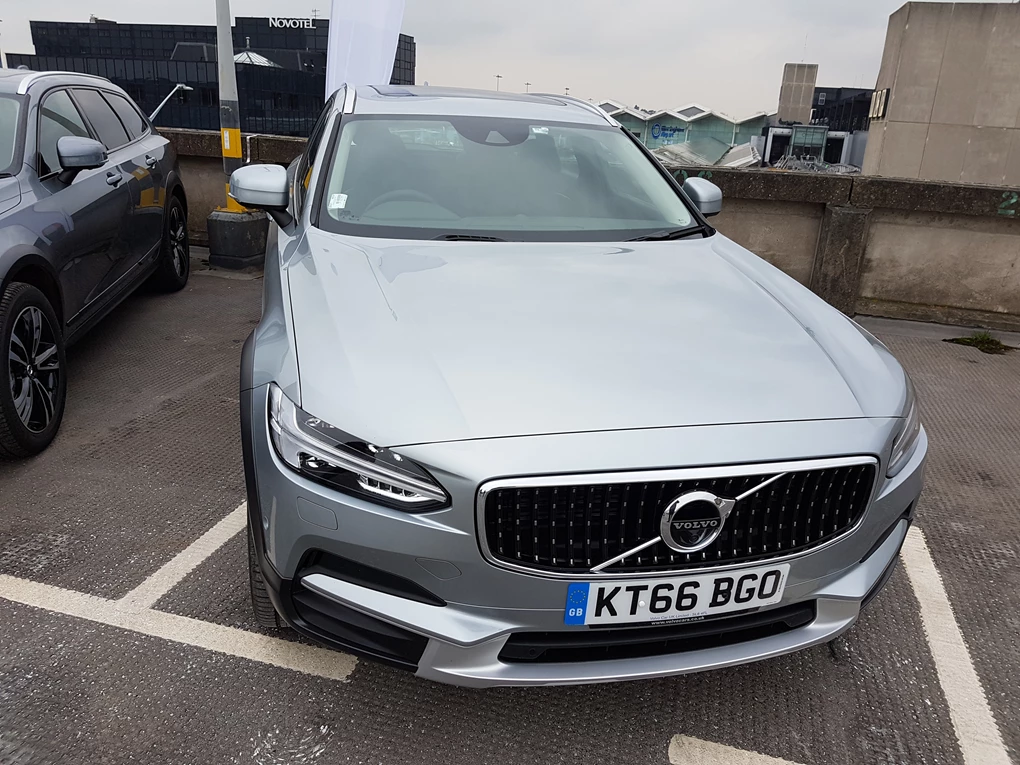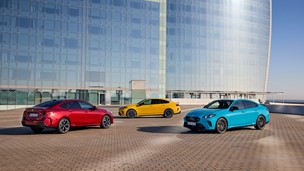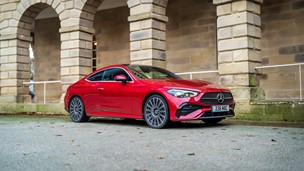Are you looking for a new family car with a big, luxurious cabin and some off-road versatility, but you don’t fancy having an SUV? If that’s the case, then cars like the Volvo V90 Cross Country are well worth a closer look.
Based on Volvo’s largest and most premium estate car, the Cross Country variant comes with an altered chassis, a raised ride height (by 60mm) and some tougher body cladding that gives the V90 a more rugged appearance. There’s also an Off-Road mode added to the driving settings which activates various driving features designed for such behaviour.
Other than the things just mentioned, the Cross Country is not much different to a ‘regular’ V90. Not that this is a bad thing though, since a regular V90 comes with the sort of slick and smart styling which modern Volvos are known for. As it sits above all other versions of the V90, the Cross Country comes with a lengthy kit list too.
But is the V90 Cross Country a good alternative to luxury SUVs? And how does it compare to other alternatives like the Audi A6 Allroad and Mercedes E-Class All-Terrain?

Performance
Alongside a couple of 2.0-litre petrol engines available, there are also two 2.0-litre diesel engines to choose which are expected to be more popular choices.
The diesels include the D4 unit, which produces 187bhp, but we tried out the more powerful D5 variant which boasts 232bhp and 480Nm of torque. An eight-speed automatic gearbox is standard with the D5 engine, instead of an option like it is with the D4 unit. All-wheel drive (AWD) is standard for all V90 Cross Country specs.
With its D5 engine, the V90 Cross Country covers the 0-62mph sprint in just 7.5 seconds and can hit a top speed of 140mph. Featuring Volvo’s latest ‘PowerPulse’ engine technology, the engine feels punchy and responsive at all speeds and it’s also impressively refined.
The pace of the D5 actually doesn’t feel massively different when compared to the more affordable D4 engine. But if you plan to make use of the Cross Country off-road talents on a regular basis, then the extra grunt from the D5 will prove very welcoming.
Ride and Handling
Whether you’re on twisty country roads or the motorway, the V90 in Cross Country guise is generally a smooth, refined and comfortable driving experience.
The V90 Cross Country is set-up with the possibility of some off-road driving in mind but it still feels very comfort-focused when it comes to on-the-road dynamics. As well as making the car taller than a regular V90, the Cross Country also has widened front and rear tracks to benefit the car’s stability. Whether you’re on twisty country roads or the motorway, the V90 in Cross Country guise is generally a smooth, refined and comfortable driving experience. It does inevitably lean more through the corners than the V90 and many other estates, and the steering, while light and precise, doesn’t offer that much feedback. These factors will discourage drivers from taking corners in an enthusiastic manner. It’s not quite as sharp as some of its German rivals then, but the Volvo does feel like it’s meant to be driven in one particular way when on the road – as relaxed as possible. As for the Cross Country’s off-road abilities, the V90 makes some handy adjustments when you activate the Off-road driving mode. Changes include making the car hold on to first and second gears longer and activating Hill Descent Control when you reach the crest of a hill. It’s not meant for serious off-road challenges like a proper SUV would handle, but the V90 Cross Country should prove versatile enough should you want to go anywhere that requires negotiating muddy tracks or fields.
Interior and Equipment
The all-wheel drive (AWD) V90 Cross Country arrives twenty years after Volvo launched its first production car with an AWD powertrain: the 850 Estate which debuted in May 1996.
Save for some specific detailing in the leather trim and the matte wood dash inlays, the interior of the Cross Country is virtually identical to the regular V90. Owners are unlikely to mind though, especially when considering how spacious, luxurious and comfortable this car feels inside. Volvo have frequently done a good job of making interiors which feel classy and noticeably different to the competition and the V90 Cross Country is no exception. The controls, including the onboard nine-inch touchscreen, feel well made and easy enough to use and the various trim panels and leather upholstery feel solidly put together. The middle rear seat might be a bit tight for six-footers, but everywhere else there’s absolutely loads of head and legroom. At the back, there’s 560 litres of boot space as standard, not as much as the Mercedes E-Class All-Terrain but still plenty for a weekly shop. You can fold the rear seats flat to expand load capacity to 1,526 litres. Whereas the regular V90 has a few trim levels, the Cross Country is more of a standalone model and thus you get a decent amount of standard kit. The list includes sat-nav, Bluetooth, LED headlamps, rain-sensing wipers, climate control and Pilot Assist. The latter feature is a semi-autonomous driving aid that can keep you in lane at a consistent speed and at a consistent distance to the car in front.
Cost
If you want the D5 engine you’ll need to spend at least just over £43,500.
The Volvo V90 Cross Country starts at £39,785, which is a few grand more than the starting price of the regular estate. With a budget of around £40k, there are quite a few premium estates and SUVs from German brands one could choose, and if you want the D5 engine you’ll need to spend at least just over £43,500. The combined fuel economy of the Cross Country is recorded at a respectable 53.3mpg, which is only slightly behind the D4’s figure of 54.3mpg. CO2 emissions are also unremarkable but reasonable at 139g/km for the D5 (just one g/km more than with the D4). As is the case with most premium German cars nowadays, there are quite a few options to choose with the Volvo V90 Cross Country. However, adding just a few could send the total price of the car skyrocketing, so careful consideration of any option your thinking of is recommended. For instance, getting the Active Four-C Chassis with Adaptive Dampers and rear Electronic Air Suspension costs £1,500 to add. Features such as smartphone integration, keyless entry and start and an electric passenger seat and metallic paint cost between £300 and £700 to add.
Our Verdict
There’s a lot to like about the Volvo V90 estate and the Cross Country variant gives you some welcome versatility if driving experiences will include trekking fields or muddy routes on occasions. It’s not quite as poised as other premium estates on the market, but the V90 Cross Country is still admirably comfortable and quiet to drive and either the D4 or D5 make for strong diesel engines. Is there anything performance or practicality-wise that makes this car stand out next to other off-road-orientated estates from the likes of, say, Audi or Mercedes? Not really, but people often buy Volvos because they want something more original than the usual offerings from Germany. Like other Volvos, the V90 Cross Country offers you something that feels more unique without sacrificing quality, and it’s an intriguing contrast in a market that feels swarmed by SUVs nowadays.




